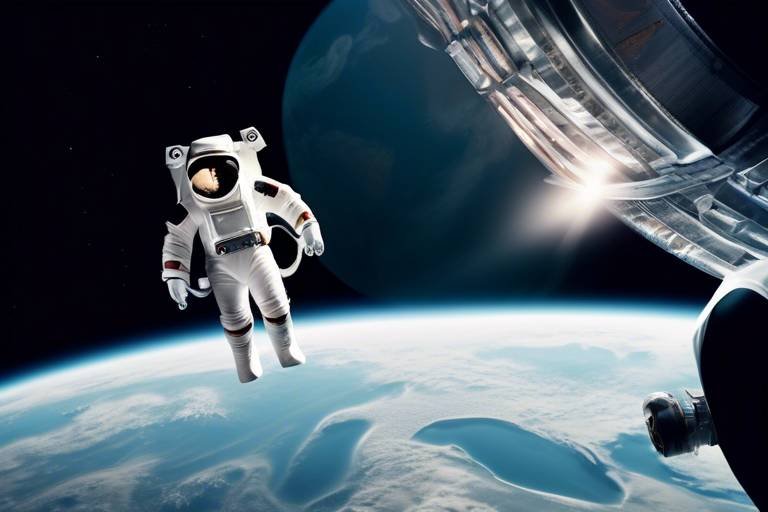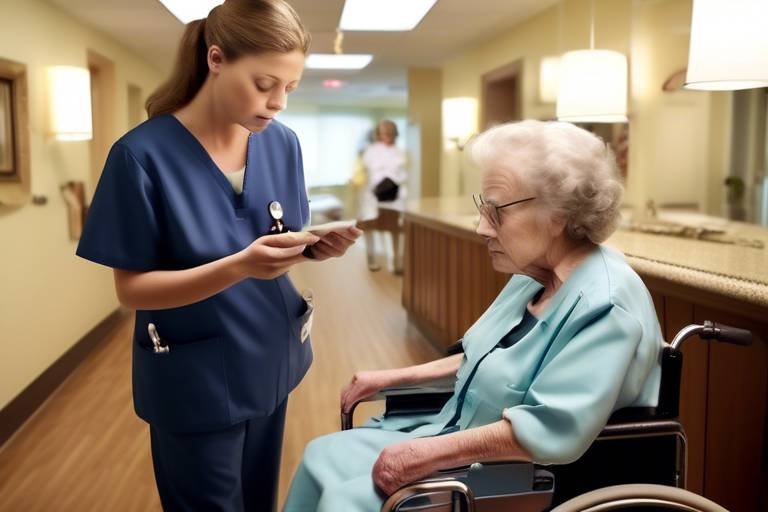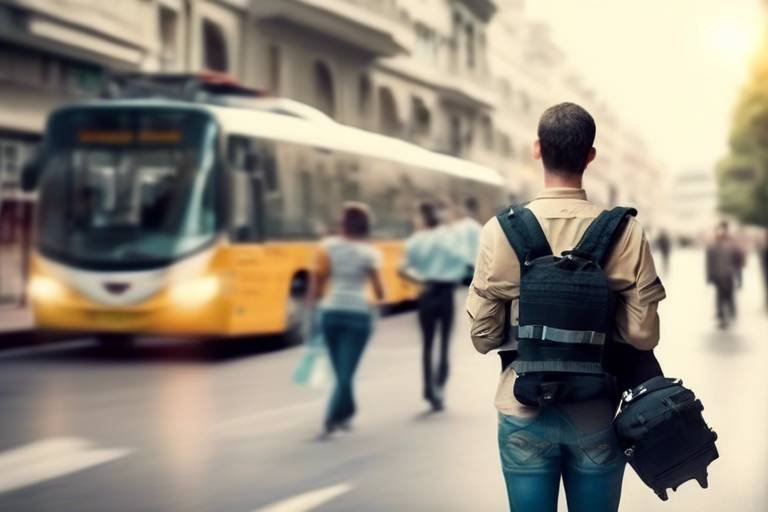How Safe is Space Travel?
Space travel has always been a tantalizing dream for humanity, an adventure that promises the thrill of exploration beyond our planet. But with this excitement comes a critical question: how safe is it really? As we stand on the brink of a new era in space exploration, understanding the safety measures, risks, and technological advancements in this field is more important than ever. With each mission, we learn more about the challenges that astronauts face and the steps taken to ensure their safety. This article will delve into the current state of human spaceflight, examining the rigorous protocols in place and what the future may hold for this exciting frontier.
To appreciate the safety of space travel today, we must first look back at its history. The early days of space exploration were fraught with peril. From the catastrophic losses during the Apollo program to the tragic accidents of the Space Shuttle Challenger and Columbia, each incident taught us invaluable lessons about safety. These milestones have shaped the evolution of safety protocols, leading to significant advancements in astronaut protection. For instance, after the Challenger disaster in 1986, NASA implemented stricter checks and balances, emphasizing the importance of safety over timelines. Today, space agencies around the world prioritize rigorous safety measures, learning from the past to build a more secure future for space travelers.
In the present day, safety protocols in space missions are more sophisticated than ever. Space agencies, including NASA and ESA, have established comprehensive safety measures that cover every aspect of a mission, from pre-launch preparations to post-landing recovery. Before a mission, extensive checks are performed on the spacecraft, ensuring that every component functions as intended. During the launch phase, real-time monitoring allows ground control to respond swiftly to any anomalies. Once in space, astronauts follow strict operational procedures designed to mitigate risks. These protocols are not just bureaucratic red tape; they are life-saving measures that have been honed through years of experience.
A crucial element of astronaut safety is the rigorous training they undergo. Astronaut training programs are designed to prepare individuals for the unique challenges of space travel. This includes extensive simulations that mimic potential emergencies, allowing astronauts to practice their responses in a controlled environment. The training covers a wide range of scenarios, from equipment malfunctions to medical emergencies. By the time they are ready for launch, astronauts have developed the skills and confidence necessary to handle unexpected situations in the vastness of space.
Simulation exercises are vital for preparing astronauts for real-life scenarios. These exercises range from virtual reality simulations to full-scale mock-ups of spacecraft. They allow astronauts to experience the pressures of decision-making in high-stress situations. For example, during a simulation exercise, astronauts might face a sudden loss of cabin pressure, requiring them to quickly don oxygen masks and execute emergency protocols. Such training not only enhances their technical skills but also builds teamwork and communication, essential elements for successful missions.
Ensuring astronauts are physically and mentally prepared for space travel is paramount. Before embarking on their missions, astronauts undergo rigorous health assessments, including tests for cardiovascular fitness, strength, and endurance. Additionally, psychological evaluations are conducted to ensure they can cope with the isolation and stress of space travel. After all, being confined in a spacecraft for months can take a toll on one's mental health. Space agencies recognize the importance of psychological readiness, providing support systems to help astronauts manage the unique challenges they face.
Technological innovations in spacecraft design have significantly enhanced safety. Modern spacecraft are equipped with advanced life support systems that monitor air quality, temperature, and humidity, ensuring a habitable environment for astronauts. Additionally, structural integrity has improved, with materials designed to withstand the harsh conditions of space. Emergency response capabilities have also advanced, with automated systems that can detect and correct malfunctions before they escalate. These technologies not only protect astronauts but also instill confidence in the safety of space travel.
Despite the advancements in safety, space travel is not without its risks. Understanding these hazards is crucial for anyone considering a journey beyond Earth. Astronauts face various challenges, including radiation exposure, microgravity effects, and equipment failures. Each of these risks requires careful management and mitigation strategies to ensure the safety of the crew.
Radiation is one of the most significant threats to astronauts in space. Beyond Earth's protective atmosphere, astronauts are exposed to cosmic rays and solar radiation, which can increase their risk of cancer and other health issues. To combat this, spacecraft are designed with shielding materials that reduce radiation exposure. Additionally, mission planners carefully select flight paths to minimize time spent in high-radiation areas, and astronauts are trained to monitor radiation levels during their missions.
Living in microgravity has profound effects on the human body. Astronauts experience muscle atrophy, bone density loss, and fluid shifts that can affect vision and overall health. Research is ongoing to understand these effects better and develop countermeasures, such as exercise regimens and nutritional strategies, to help maintain astronaut health during long missions. NASA's ongoing studies aim to ensure that future explorers can thrive in the unique environment of space.
Looking ahead, the future of space travel safety is promising. As technology continues to advance, we can expect even more robust safety protocols and international collaboration among space agencies. Future missions to Mars and beyond will necessitate innovative solutions to ensure astronaut safety. Concepts such as autonomous spacecraft and improved radiation shielding are on the horizon, paving the way for safer exploration of our solar system and beyond. With each advancement, we move closer to making space travel a safe and accessible reality for all.
- What are the main risks associated with space travel? The main risks include radiation exposure, equipment failures, and the effects of microgravity on the human body.
- How do astronauts prepare for emergencies in space? Astronauts undergo extensive training, including simulation exercises, to prepare for potential emergencies they may encounter during missions.
- What technological advancements have improved safety in space travel? Innovations such as advanced life support systems, improved materials for spacecraft, and automated emergency response systems have enhanced safety.
- How does microgravity affect astronauts' health? Microgravity can lead to muscle atrophy, bone density loss, and fluid shifts, requiring specific countermeasures to maintain health during missions.

Historical Overview of Space Travel Safety
When we think about space travel, it’s easy to get lost in the excitement of exploration and discovery. However, the journey to making space travel safe has been a long and arduous one. From the early days of rocketry to the sophisticated missions we see today, safety has always been a top priority, albeit not always successfully. The history of space travel safety is rich with milestones, each teaching us invaluable lessons that have shaped the protocols we have in place now.
The early missions of the 1960s, such as the Soviet Union's Vostok program and NASA's Mercury missions, were groundbreaking but also fraught with danger. For instance, the tragic loss of the Apollo 1 crew in 1967 highlighted the critical need for stringent safety measures. This incident, caused by a cabin fire during a pre-launch test, served as a wake-up call for NASA and led to a complete overhaul of safety protocols. In the aftermath, a series of safety reviews and redesigns were implemented, ensuring that future missions would be better prepared for emergencies.
Over the decades, various space agencies have adopted a culture of safety that is now deeply embedded in their operations. For example, NASA's Space Shuttle program, which operated from 1981 to 2011, introduced extensive safety checks and redundancy systems. These systems were designed to ensure that if one component failed, others could take over, effectively safeguarding the crew. The Challenger and Columbia disasters, which resulted in the loss of 14 astronauts, further emphasized the importance of rigorous safety protocols and risk management in space missions.
As we moved into the 21st century, the landscape of space travel began to change rapidly. With the advent of commercial spaceflight, new players entered the arena, bringing fresh perspectives on safety. Companies like SpaceX and Blue Origin have been at the forefront of this revolution, implementing innovative technologies and safety measures. For instance, SpaceX's Crew Dragon spacecraft is equipped with an advanced launch escape system that can rapidly propel the crew away from the rocket in case of an emergency during launch.
To summarize the historical evolution of space travel safety, we can highlight several key milestones:
- 1960s: Early missions faced numerous risks, leading to the establishment of basic safety protocols.
- 1967: The Apollo 1 tragedy prompted a complete reevaluation of safety measures within NASA.
- 1981-2011: The Space Shuttle program introduced extensive safety checks and redundancy systems.
- 21st Century: The rise of commercial spaceflight has brought new innovations and safety strategies.
Today, space agencies around the world are more committed than ever to ensuring the safety of their astronauts. With each mission, they gather data, analyze outcomes, and continually refine their protocols. The lessons learned from past mistakes have paved the way for a safer and more secure future in space travel. As we look ahead, we can only imagine what new safety measures and technologies will emerge, making human spaceflight an even more reliable endeavor.
Q: What was the biggest safety failure in early space travel?
A: The Apollo 1 fire in 1967, which resulted in the tragic loss of three astronauts, is considered one of the most significant safety failures in early space travel.
Q: How do modern spacecraft ensure astronaut safety?
A: Modern spacecraft, like SpaceX's Crew Dragon, incorporate advanced safety features such as launch escape systems, redundant life support systems, and rigorous pre-launch checks.
Q: What role does training play in astronaut safety?
A: Astronaut training is crucial; it prepares crew members for potential emergencies through simulation exercises and physical and psychological assessments.

Current Safety Protocols in Space Missions
When it comes to space travel, safety is the name of the game. With the vastness of space being both awe-inspiring and intimidating, space agencies around the world have established a comprehensive framework of safety protocols designed to protect astronauts from a multitude of potential hazards. These protocols encompass every facet of a mission—from the moment astronauts step into their training shoes to the second they return to Earth. Each phase is meticulously planned and executed to ensure that the risks are minimized, and the astronauts are well-prepared for whatever challenges they might face.
One of the cornerstones of current safety protocols is the rigorous pre-launch checklist. This checklist is a detailed document that outlines every step that needs to be taken before a mission can proceed. It includes everything from checking the spacecraft systems to ensuring that all crew members have completed their health assessments. Imagine it as a pilot's pre-flight checklist, but with the stakes raised to astronomical levels—literally! Each item on this checklist is a safeguard, ensuring that nothing is overlooked.
Moreover, the protocols extend into the realm of real-time monitoring during the mission. Ground control teams continuously monitor spacecraft systems and astronaut health through a series of advanced technologies. For instance, telemetry systems provide real-time data about the spacecraft’s status, allowing ground teams to respond quickly to any anomalies. This is crucial because, in the void of space, every second counts. If something goes wrong, swift action can mean the difference between a minor issue and a major crisis.
Additionally, astronauts undergo extensive training, which is a vital component of safety protocols. This training includes hands-on simulations that mimic various emergency scenarios. Imagine being in a high-pressure situation, like a fire breaking out in the spacecraft or a critical system failure. The astronauts are trained to respond effectively, using their skills and knowledge to resolve the situation. This preparation is akin to a firefighter training for a blaze; they must be ready for anything at a moment’s notice.
Astronaut training programs are designed to prepare individuals for the unique challenges of space travel. This training includes physical conditioning, technical skills development, and emergency response drills. Each astronaut must meet stringent health and fitness standards, ensuring they can withstand the physical demands of launch, microgravity, and re-entry. Furthermore, they learn how to operate complex spacecraft systems and conduct scientific experiments, all while being trained to handle emergencies that may arise during the mission.
Simulation exercises play a pivotal role in astronaut training. These exercises replicate real-life scenarios that astronauts may encounter in space, allowing them to practice their responses in a controlled environment. For example, astronauts might undergo a simulation of a cabin depressurization, requiring them to don oxygen masks and follow emergency protocols. These drills are not just about memorizing steps; they are designed to enhance decision-making and crisis management skills under pressure.
Ensuring that astronauts are both physically and mentally fit is crucial for mission success. Before embarking on a spaceflight, astronauts undergo health assessments to evaluate their physical condition. This includes tests on cardiovascular health, vision, and overall fitness. Psychological evaluations are equally important, as the isolation and stress of space travel can take a toll on mental health. Astronauts are equipped with coping strategies and support systems to handle the psychological demands of their missions.
In summary, the current safety protocols in space missions are a multi-faceted approach that combines thorough training, real-time monitoring, and rigorous pre-launch checks. These measures ensure that astronauts are well-prepared to face the challenges of space travel, making each mission as safe as possible. As we continue to push the boundaries of exploration, these protocols will evolve, incorporating new technologies and insights to enhance astronaut safety even further.
- What are the main safety protocols for astronauts?
Astronauts undergo extensive training, including emergency simulations and health assessments, and follow rigorous pre-launch checklists. - How are astronauts trained for emergencies?
They participate in simulation exercises that replicate real-life scenarios, enhancing their decision-making skills under pressure. - What kind of health checks do astronauts undergo?
Astronauts are evaluated for physical fitness and mental health before missions to ensure they can handle the stresses of space travel.

Training for Astronauts
When it comes to space travel, the **training of astronauts** is not just important; it’s absolutely critical. Imagine preparing for a journey where the nearest hospital is millions of miles away! Astronauts undergo a rigorous training regimen designed to equip them with the skills needed to handle emergencies and navigate the unpredictable environment of space. This training can be likened to preparing for a marathon, where both physical endurance and mental resilience are tested to the limit.
The training process is comprehensive and multifaceted, encompassing various aspects that ensure astronauts are ready for the challenges they will face. From technical skills to physical fitness, astronauts must master a wide array of competencies. They train in environments that simulate the conditions of space, including microgravity and high-pressure situations. This is where the magic happens—astronauts learn to operate spacecraft systems, conduct scientific experiments, and manage potential crises.
One of the key components of astronaut training is the **simulation exercises**. These exercises replicate real-life scenarios that astronauts might encounter while in space. For instance, they may practice responding to equipment malfunctions or medical emergencies. These simulations are conducted in specialized facilities that mimic the conditions of space travel, allowing astronauts to gain hands-on experience in a controlled environment. This type of training builds not only their technical skills but also their decision-making abilities under pressure.
Furthermore, the physical and psychological preparedness of astronauts cannot be overstated. Prior to their missions, astronauts undergo extensive health assessments to ensure they are physically fit to handle the rigors of space travel. This includes cardiovascular tests, strength evaluations, and even assessments of their vision and hearing. On the psychological side, astronauts participate in evaluations designed to gauge their mental resilience and ability to cope with stress. After all, spending months in a confined space with limited social interaction can take a toll on anyone’s mental health.
In addition to the physical and psychological evaluations, astronauts also engage in team-building exercises. Working as part of a crew in space requires a high level of trust and cooperation. Through these exercises, astronauts learn to communicate effectively and resolve conflicts, which are crucial skills for maintaining harmony during long missions.
Overall, the training of astronauts is a **meticulous and demanding process** that ensures they are fully prepared for the unique challenges of space travel. From mastering technical skills to developing the mental fortitude needed to thrive in an isolated environment, astronauts are trained to be the best of the best. As we look to the future of space exploration, the importance of rigorous astronaut training will only continue to grow, paving the way for safer and more successful missions.
- How long does astronaut training last? Astronaut training can last anywhere from 1 to 3 years, depending on the individual and the specific mission requirements.
- What types of skills do astronauts learn during training? Astronauts learn a variety of skills, including spacecraft operation, scientific research methods, emergency procedures, and physical fitness techniques.
- Are astronauts trained to handle medical emergencies? Yes, astronauts undergo medical training to handle emergencies, including first aid and basic medical procedures.

Simulation Exercises
When it comes to space travel, the phrase “practice makes perfect” takes on a whole new meaning. Astronauts undergo a series of that are designed to prepare them for the unpredictable nature of space missions. These exercises are not just about familiarizing astronauts with their spacecraft; they are meticulously crafted to mimic real-life scenarios that could arise during a mission. Imagine being in a confined space, millions of miles from Earth, and suddenly facing a critical failure—this is where simulation exercises shine.
One of the primary goals of these simulations is to enhance decision-making and crisis management skills. Astronauts are put through their paces in a controlled environment, where they can experience the pressures of space travel without the actual risks. They might find themselves dealing with equipment malfunctions, unexpected changes in mission parameters, or even medical emergencies. Each of these scenarios is carefully designed to challenge their problem-solving abilities and teamwork.
During these simulation exercises, astronauts often work with advanced technologies and equipment that they will use in space. For instance, they might engage in virtual reality (VR) simulations that allow them to practice maneuvers in a lifelike setting. This technology provides a 360-degree view of their surroundings, helping them to visualize and react to situations as they would in space. The immersive experience of VR can significantly reduce the learning curve for astronauts, making them more adept at handling real-life challenges.
Furthermore, these exercises are not just limited to technical skills. They also focus on the astronauts' mental resilience and team dynamics. Astronauts often work in small teams, and their ability to communicate and collaborate effectively can be the difference between success and failure in a mission. By simulating high-pressure situations, teams can learn to rely on each other, fostering a sense of camaraderie that is essential for long-duration missions.
In summary, simulation exercises are a cornerstone of astronaut training. They serve as a vital bridge between theory and practice, ensuring that astronauts are not only technically proficient but also mentally prepared for the challenges of space travel. As we continue to push the boundaries of exploration, these exercises will remain a critical component of astronaut training, ensuring that our brave explorers are ready for anything the cosmos throws their way.

Physical and Psychological Preparedness
When it comes to space travel, the physical and psychological preparedness of astronauts is not just a box to check—it's a fundamental aspect of their training and overall mission success. Imagine preparing for a marathon, but instead of just running, you're also training your mind to handle extreme isolation, confinement, and the unknown. This dual preparation ensures that astronauts can face the numerous challenges of space travel head-on.
Before embarking on their extraordinary journey, astronauts undergo a series of rigorous health assessments. These evaluations are designed to ensure that they are in top physical condition, as even minor health issues can be exacerbated in a microgravity environment. Factors such as cardiovascular health, muscle strength, and bone density are meticulously monitored. For instance, astronauts often participate in a series of physical tests that include:
- Cardiovascular endurance tests
- Strength training assessments
- Flexibility evaluations
However, physical fitness is just one piece of the puzzle. The psychological aspect is equally critical. Astronauts must be mentally resilient, capable of coping with the stresses of long-duration missions, which can last months or even years. To prepare for this, they engage in various psychological evaluations and training exercises. These sessions help them develop coping strategies for:
- Isolation and confinement
- Team dynamics and conflict resolution
- Stress management techniques
The importance of mental health cannot be overstated. In the confined quarters of a spacecraft, astronauts must work closely with their crewmates, often in high-pressure situations. This is where psychological training plays a pivotal role. Astronauts learn to recognize signs of stress in themselves and others, fostering an environment where open communication is encouraged. This proactive approach can make all the difference in maintaining harmony and ensuring mission success.
Moreover, the use of advanced technologies, such as virtual reality (VR) simulations, has become an integral part of astronaut training. These simulations allow astronauts to experience various scenarios they might encounter in space, from equipment malfunctions to emergency landings. By immersing themselves in these situations, they can practice their responses, enhancing both their decision-making and crisis management skills. It’s like a dress rehearsal for the most important show of their lives!
In summary, the physical and psychological preparedness of astronauts is a multifaceted process that combines rigorous health assessments with comprehensive mental training. As space travel continues to evolve, the emphasis on these aspects will only grow, ensuring that our explorers are ready to tackle the challenges of the final frontier.
- What kind of physical tests do astronauts undergo?
Astronauts participate in cardiovascular endurance tests, strength training assessments, and flexibility evaluations to ensure they are fit for space travel. - How do astronauts prepare for psychological challenges?
They engage in psychological evaluations, stress management techniques, and team-building exercises to enhance their mental resilience. - Why is mental health important for astronauts?
Mental health is crucial for maintaining harmony and ensuring mission success, especially in the confined quarters of a spacecraft. - What role do simulations play in astronaut training?
Simulations allow astronauts to practice their responses to various scenarios, enhancing their decision-making and crisis management skills.

Technological Advancements in Spacecraft
In the ever-evolving realm of space travel, technological advancements in spacecraft have become pivotal in ensuring the safety and success of missions. As we venture beyond our planet, the challenges posed by the harsh environment of space necessitate cutting-edge innovations that enhance astronaut safety and mission reliability. From improved structural integrity to advanced life support systems, these technological breakthroughs are not just enhancements; they are lifelines that protect astronauts as they explore the final frontier.
One of the most significant advancements in spacecraft technology is the development of automated systems designed to monitor and control various spacecraft functions. These systems are equipped with artificial intelligence that can predict and react to potential failures, allowing for real-time adjustments that ensure the safety of the crew. For instance, if a critical system begins to malfunction, the automated systems can initiate backup protocols, alert the crew, and even take corrective actions without human intervention. This level of automation reduces the cognitive load on astronauts, allowing them to focus on their mission objectives.
Moreover, advancements in materials science have led to the creation of stronger and lighter materials that enhance the structural integrity of spacecraft. The use of advanced composites and alloys not only improves the durability of spacecraft but also contributes to fuel efficiency. When a spacecraft is lighter, it requires less thrust to launch, which translates into reduced fuel consumption and lower costs. This is crucial for long-duration missions, such as those planned for Mars, where every ounce counts.
Another critical area of innovation is in life support systems. Modern spacecraft are equipped with sophisticated systems that recycle air and water, ensuring that astronauts have a sustainable supply of these vital resources. These systems utilize advanced filtration and purification technologies that can convert waste products back into usable resources. For example, the International Space Station (ISS) employs a water recovery system that can reclaim about 90% of the water from urine, sweat, and cabin humidity. This not only conserves resources but also minimizes the need for resupply missions from Earth.
In addition to these systems, safety protocols have been integrated into spacecraft design to protect astronauts during emergencies. For instance, spacecraft are now equipped with emergency escape systems that can quickly propel the crew away from the vehicle in the event of a catastrophic failure during launch. These systems are designed to activate automatically, ensuring that even in high-stress situations, astronauts have a reliable means of escape.
Furthermore, advancements in communication technology have improved the ability of astronauts to stay connected with mission control. High-frequency communication systems allow for real-time data transmission, enabling ground teams to monitor the health and status of the spacecraft continuously. This connectivity is essential for troubleshooting issues that may arise during missions and for providing psychological support to astronauts who may feel isolated in the vastness of space.
As we look to the future, the integration of robotics and automation into spacecraft design is poised to revolutionize space travel. Robotic systems can undertake routine maintenance and repair tasks, reducing the burden on astronauts and allowing them to focus on scientific research and exploration. Imagine a future where robotic assistants are commonplace on spacecraft, handling everything from equipment repairs to conducting experiments, all while astronauts concentrate on their mission goals.
In conclusion, the technological advancements in spacecraft are not merely enhancements; they are essential components that ensure the safety and success of space missions. As we continue to push the boundaries of human exploration, these innovations will play a crucial role in safeguarding the lives of astronauts and enabling humanity to thrive beyond our planet.
- What are the most critical technological advancements in spacecraft? The most critical advancements include automated systems, improved materials for structural integrity, advanced life support systems, emergency escape systems, and enhanced communication technologies.
- How do life support systems work in spacecraft? Life support systems recycle air and water, using advanced filtration and purification technologies to ensure astronauts have a sustainable supply of these vital resources.
- What role do robotics play in future space missions? Robotics will likely take on routine maintenance and repair tasks, allowing astronauts to focus on scientific research and exploration.

Risks Associated with Space Travel
Understanding the risks involved in space travel is crucial for anyone interested in this exciting yet perilous frontier. When we think of space, we often visualize the breathtaking beauty of the stars and the vastness of the universe, but lurking beneath that allure are significant challenges that astronauts face. From the moment a spacecraft launches to the final descent back to Earth, astronauts encounter a variety of hazards that demand rigorous planning and precautionary measures.
One of the most pressing concerns is radiation exposure. In space, astronauts are bombarded by cosmic rays and solar particles, which can pose severe health risks. Unlike on Earth, where our atmosphere provides a protective shield, space lacks this natural barrier. The potential consequences of prolonged exposure to radiation include an increased risk of cancer, damage to the central nervous system, and other serious health issues. To combat this, space agencies have implemented several protective measures:
- Shielding Materials: Spacecraft are designed with materials that help reduce radiation exposure.
- Monitoring Systems: Astronauts wear dosimeters to track their radiation exposure throughout the mission.
- Mission Duration Limitations: Missions are carefully planned to limit exposure time in high-radiation environments.
Another significant risk is the effects of microgravity on the human body. Living in a microgravity environment can lead to a range of physiological changes, including muscle atrophy, bone density loss, and fluid redistribution. These changes can affect an astronaut's health both during and after their missions. Research is ongoing to understand these effects better, and countermeasures are being developed, such as:
- Exercise Regimens: Astronauts engage in daily exercise routines to mitigate muscle and bone loss.
- Nutrition Plans: Tailored diets are provided to ensure astronauts receive essential nutrients.
- Medical Monitoring: Continuous health assessments are conducted to catch any adverse effects early.
Additionally, equipment failures pose another layer of risk during space missions. The complexities of spacecraft systems mean that any malfunction can have dire consequences. For instance, life support systems must function flawlessly to provide oxygen and remove carbon dioxide. To address these risks, rigorous testing and redundancy systems are put in place. Spacecraft are equipped with backup systems, and astronauts undergo extensive training to manage potential failures effectively.
In summary, while space travel is filled with wonder and opportunity, it also comes with a unique set of risks that require careful consideration and preparation. As technology advances and our understanding of space deepens, the measures taken to protect astronauts continue to evolve. The ultimate goal remains clear: to make space travel as safe as possible for those brave enough to venture into the unknown.
What are the main risks of space travel?
The primary risks include radiation exposure, the effects of microgravity on the body, and potential equipment failures.
How do astronauts protect themselves from radiation?
Astronauts are protected through shielding materials in their spacecraft, monitoring systems to track radiation exposure, and limitations on mission duration.
What effects does microgravity have on astronauts?
Microgravity can lead to muscle atrophy, bone density loss, and fluid redistribution, among other physiological changes.
How is astronaut health monitored during missions?
Astronauts undergo continuous health assessments, including exercise regimens and nutrition plans, to monitor and maintain their health in space.

Radiation Exposure
When we think about space travel, one of the most alarming issues that come to mind is . It's not just a buzzword; it's a genuine concern for astronauts venturing beyond the protective embrace of Earth's atmosphere. In space, there are various sources of radiation, including cosmic rays and solar particles, which can pose serious health risks. Imagine standing in a sunbeam on Earth, but instead of just warmth, you're bombarded with high-energy particles that can penetrate your body and wreak havoc at a cellular level. This is the reality for astronauts, and understanding this risk is crucial for their safety.
To give you a clearer picture, let’s break down the types of radiation that astronauts encounter:
- Galactic Cosmic Rays (GCRs): These are high-energy particles originating from outside our solar system. They are a significant concern due to their ability to penetrate spacecraft and human tissue.
- Solar Particle Events (SPEs): These occur during solar flares and can release bursts of energetic particles. The risk from SPEs is heightened during periods of solar activity.
- Secondary Radiation: When cosmic rays hit the spacecraft's structure, they can produce secondary radiation, which can further increase exposure levels.
To combat these radiation threats, space agencies have implemented several protective measures. For instance, spacecraft are designed with shielding materials that can absorb or deflect some of the radiation. Additionally, astronauts are monitored with dosimeters that track their radiation exposure levels throughout their missions. This is akin to wearing a safety belt in a car; it's a precaution that can make a significant difference in ensuring safety.
Moreover, mission planners carefully select flight paths and schedules to minimize exposure. For example, during solar storms, astronauts may be instructed to take shelter in specific areas of the spacecraft that offer the most protection. These protocols are crucial in ensuring that astronauts can safely conduct their missions without succumbing to the dangers of radiation.
Despite these measures, the long-term effects of radiation exposure remain a topic of ongoing research. Studies suggest that prolonged exposure can increase the risk of cancer and other health issues. Therefore, understanding and mitigating radiation risk is not just about current missions; it’s about paving the way for future explorations, such as missions to Mars, where astronauts could face even greater exposure due to the extended duration of travel.
In summary, while radiation exposure is a significant risk in space travel, ongoing advancements in technology and safety protocols are helping to protect astronauts. As we push the boundaries of human exploration, the commitment to understanding and addressing these risks will be paramount. The journey to the stars may be fraught with challenges, but with each mission, we learn more about how to keep our explorers safe.
- What types of radiation do astronauts face in space?
Astronauts primarily encounter Galactic Cosmic Rays (GCRs), Solar Particle Events (SPEs), and secondary radiation produced when cosmic rays interact with spacecraft materials. - How do astronauts protect themselves from radiation?
Spacecraft are designed with shielding materials, and astronauts wear dosimeters to monitor their radiation exposure. Mission planners also choose flight paths to minimize exposure during solar storms. - What are the long-term effects of radiation exposure on astronauts?
Long-term exposure to radiation can increase the risk of cancer and other health issues, which is why ongoing research is vital for future missions.

Microgravity Effects on the Human Body
When astronauts venture into space, they leave behind the comforting embrace of Earth's gravity, entering a realm where the laws of physics behave differently. This shift into microgravity can have profound effects on the human body, both short-term and long-term. Imagine floating in a pool, where every movement feels effortless, but instead of a refreshing dip, astronauts are navigating a complex environment that can challenge their very physiology.
One of the most immediate effects of microgravity is the loss of muscle mass and bone density. Without the constant pull of gravity, the muscles that help us stand, walk, and perform everyday activities begin to weaken. Studies have shown that astronauts can lose up to 20% of their muscle mass and experience significant bone loss during missions lasting six months or longer. This phenomenon is akin to aging rapidly in a matter of months; the body, which is accustomed to the demands of gravity, begins to atrophy in the absence of it.
Another critical issue is the fluid shift that occurs in microgravity. On Earth, gravity pulls bodily fluids downwards, but in space, fluids redistribute throughout the body. This can lead to facial puffiness and increased intracranial pressure, which may cause headaches and vision problems. Astronauts often report a sensation similar to that of a sinus infection, as their bodies adjust to this new gravitational environment.
Moreover, microgravity poses challenges to the cardiovascular system. The heart, which pumps blood against gravity, may experience changes in its shape and function. Astronauts have reported a decrease in heart rate and changes in blood volume, which can lead to a condition known as orthostatic intolerance. This is when astronauts feel dizzy or faint upon returning to Earth, as their bodies struggle to readjust to gravity's demands.
To combat these effects, space agencies implement rigorous exercise regimens using specialized equipment designed to simulate the resistance of gravity. This is crucial not only for maintaining muscle and bone health but also for ensuring that astronauts can effectively perform their duties in space. For instance, astronauts on the International Space Station (ISS) engage in daily workouts, utilizing treadmills, stationary bikes, and resistance machines to counteract the detrimental impacts of microgravity.
Additionally, research is continually being conducted to understand the long-term implications of microgravity on human health. Scientists are exploring various countermeasures, including nutritional interventions and pharmaceutical solutions, to mitigate these effects. Understanding how microgravity affects the human body is essential, especially as we look toward longer missions, such as those planned for Mars.
In summary, while microgravity opens up a world of possibilities for exploration and discovery, it also presents significant challenges to human physiology. As we continue to push the boundaries of space travel, it is crucial to prioritize the health and well-being of astronauts, ensuring they are equipped to handle the unique stresses of life beyond our planet.
- What are the main effects of microgravity on the human body? The main effects include muscle atrophy, bone density loss, fluid redistribution, and cardiovascular changes.
- How do astronauts maintain their health in space? Astronauts engage in daily exercise routines, consume a balanced diet, and participate in health monitoring to mitigate the effects of microgravity.
- What long-term impacts can microgravity have on astronauts? Long-term impacts may include increased risk of osteoporosis, cardiovascular issues, and potential vision problems due to fluid shifts.
- Are there any countermeasures being developed for microgravity effects? Yes, ongoing research is focused on nutritional supplements, exercise regimens, and even medications to help counteract the negative effects of microgravity.

The Future of Space Travel Safety
As we gaze into the cosmos, the future of space travel safety is not just a distant dream but a tangible reality that is rapidly approaching. With each passing year, advancements in technology and international cooperation are paving the way for a safer journey beyond our planet. Imagine a world where space travel is as routine as catching a flight across the country; this vision is becoming more feasible as safety protocols evolve and improve.
One of the most exciting prospects for the future is the development of autonomous spacecraft. These vehicles will be equipped with advanced AI systems capable of making real-time decisions during missions, significantly reducing the risk of human error. Think about it: just like a self-driving car, an autonomous spacecraft could navigate through the complexities of space travel, responding to unforeseen challenges without relying solely on the crew’s judgment. This innovation could revolutionize the way we approach safety in space, allowing astronauts to focus on their mission objectives rather than constantly monitoring systems.
Moreover, the integration of wearable technology for astronauts is on the horizon. These devices could monitor vital signs and environmental conditions in real-time, alerting the crew to any potential health risks or system failures. Imagine an astronaut wearing a suit that not only protects them from the harsh conditions of space but also provides constant feedback about their physical and mental state. This proactive approach to health monitoring could prevent emergencies before they escalate, ensuring that astronauts are always in optimal condition during their missions.
In addition to technological advancements, international collaboration is key to enhancing space travel safety. As more nations join the race to explore space, sharing knowledge and resources becomes crucial. For instance, the establishment of a global Space Safety Coalition could facilitate the exchange of best practices and safety protocols among space agencies worldwide. This coalition could also work towards setting universal standards for spacecraft design and astronaut training, ensuring that safety is prioritized across all missions.
Furthermore, research into radiation protection remains a top priority. With long-duration missions to Mars and beyond on the horizon, scientists are exploring innovative materials and shielding techniques to safeguard astronauts from harmful cosmic radiation. Imagine a spacecraft coated with advanced materials that not only block radiation but also adapt to changing environments. Such breakthroughs could make deep space travel safer and more feasible, allowing humanity to venture further into the universe than ever before.
Finally, the future of space travel safety will undoubtedly include a greater emphasis on psychological support for astronauts. As missions become longer and more isolated, understanding the mental health challenges faced by astronauts will be paramount. Future missions may incorporate enhanced psychological training and support systems, ensuring that astronauts are not only physically prepared but also mentally resilient. This holistic approach to astronaut well-being is essential for maintaining a safe and effective crew in the demanding environment of space.
- What are some of the key advancements in space travel safety?
Key advancements include autonomous spacecraft, wearable technology for health monitoring, and enhanced radiation protection methods.
- How important is international collaboration in space travel safety?
International collaboration is crucial as it allows for the sharing of best practices, resources, and the establishment of universal safety standards.
- What role does psychological support play in astronaut safety?
Psychological support is vital for ensuring astronauts are mentally prepared for long-duration missions and can cope with the isolation and stress of space travel.
Frequently Asked Questions
- How safe is space travel for astronauts?
Space travel has become significantly safer over the years due to rigorous safety protocols and advancements in technology. Space agencies like NASA and ESA have implemented extensive training programs, emergency simulations, and cutting-edge spacecraft designs to ensure astronaut safety. While risks still exist, the measures taken today greatly reduce the chances of accidents.
- What kind of training do astronauts go through?
Astronaut training is comprehensive and multifaceted. It includes physical fitness training, technical skills development, and psychological assessments. Astronauts participate in simulation exercises that mimic real-life scenarios they might face in space, helping them to make quick decisions during emergencies.
- What are the main risks associated with space travel?
Space travel poses several risks, including exposure to radiation, equipment failures, and the effects of microgravity on the human body. Radiation from cosmic rays and solar particles can pose health threats, while microgravity can lead to muscle atrophy and bone density loss. Understanding these risks is crucial for astronaut safety.
- How do astronauts deal with radiation exposure?
To mitigate radiation exposure, spacecraft are designed with protective materials, and astronauts are trained to monitor their exposure levels. Missions are planned to minimize time spent in high-radiation areas, and scientists are continually researching better shielding technologies to enhance safety.
- What advancements are being made for the future of space travel safety?
Future advancements in space travel safety include improved spacecraft designs, enhanced life support systems, and international collaborations to share safety protocols. Research into better radiation shielding and health monitoring technologies is also underway, aiming to make space travel even safer for future generations.



















